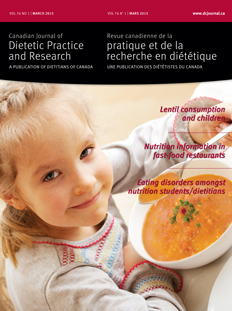Abstract
Purpose: To assess the availability, location, and format of nutrition information in fast-food chain restaurants in Ontario.
Methods: Nutrition information in restaurants was assessed using an adapted version of the Nutrition Environment Measures Study for Restaurants (NEMS-R). Two raters independently visited 50 restaurants, 5 outlets of each of the top-10 fast-food chain restaurants in Canada. The locations of the restaurants were randomly selected within the Waterloo, Wellington, and Peel regions in Ontario, Canada. Descriptive results are presented for the proportion of restaurants presenting nutrition information by location (e.g., brochure), format (e.g., use of symbols), and then by type of restaurant (e.g., quick take-away, full-service).
Results: Overall, 96.0% (n = 48) of the restaurants had at least some nutrition information available in the restaurant. However, no restaurant listed calorie information for all items on menu boards or menus, and only 14.0% (n = 7) of the restaurants posted calorie information and 26.0% (n = 13) of restaurants posted other nutrients (e.g., total fat) for at least some items on menus boards or menus.
Conclusions: The majority of the fast-food chain restaurants included in our study provided at least some nutrition information in restaurants; however, very few restaurants made nutrition information readily available for consumers on menu boards and menus.
Résumé
Objectif. Évaluer la disponibilité, l'emplacement et le format de l'information nutritionnelle dans des chaînes de restauration rapide de l'Ontario.
Méthodes. L'information nutritionnelle offerte dans les restaurants a été évaluée au moyen d'une version adaptée de la Nutrition Environment Measures Study for Restaurants (NEMS-R). Deux évaluateurs ont visité de manière indépendante 50 restaurants, soit 5 points de vente de chacune des 10 principales chaînes de restauration rapide au Canada. La localisation des restaurants a été sélectionnée au hasard dans les régions de Waterloo, de Wellington et de Peel, situées en Ontario, au Canada. Des résultats descriptifs sont présentés quant à la proportion de restaurants qui offrent de l'information nutritionnelle en fonction de leur emplacement (p. ex. brochure), de leur format (p. ex. utilisation de symboles) et du type de restaurant (p. ex. service rapide de mets à emporter, restaurant à service complet).
Résultats. Dans l'ensemble, 96,0 % (n = 48) des restaurants offraient au moins un certain niveau d'information nutritionnelle sur place. Cependant, aucun des restaurants ne présentait de renseignements sur les calories pour l'ensemble des articles offerts sur les menus ou les panneaux d'affichage des menus. Qui plus est, seulement 14,0 % (n = 7) des restaurants affichaient de l'information sur les calories et 26,0 % (n = 13) affichaient des renseignements sur des nutriments (p. ex. la teneur totale en matières grasses) pour au moins certains des articles apparaissant sur les menus ou les panneaux d'affichage des menus.
Conclusions. La plupart des chaînes de restauration rapide comprises dans notre étude fournissaient au moins un minimum d'information nutritionnelle dans leurs restaurants. Cependant, très peu de restaurants rendaient cette information facilement accessible pour les consommateurs sur les menus et panneaux d'affichage des menus.



